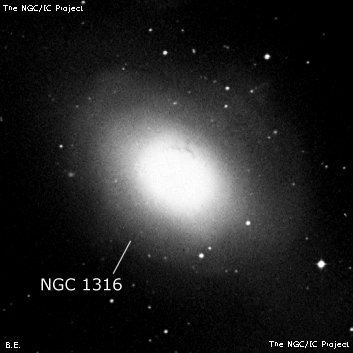Fornax A
Fornax A

James Dunlop discovered NGC 1316 = D 548 = h2527 on 2 Sep 1826 with his 9" reflector from Parramatta and described "a rather bright, round nebula, about 1.5' diameter, gradually condensed to the centre." He made two observations and his published position was pretty poor -- nearly 20' SE of the galaxy. Dunlop discovered six members of the Fornax cluster, though most (15) were found by John Herschel. Herschel first observed the galaxy on 22 Oct 1835 and noted "vB; pL; lE; vsvmbM, to a nucleus 2" in diameter." On his second sweep he logged "vB; vL; 4' diameter; 1st gradually, then very suddenly very much brighter towards the middle to a stellar ncl"
NGC 1316 is the brightest member of the Fornax cluster and is also known as Fornax A, one of the closest and most famous radio sources in the southern hemisphere. Its radio lobes extend several degrees of sky. Arp classified it as a disturbed galaxy with interior absorption -- like Centaurus A, NGC 1316 contains an extensive system of dust filaments as well as low surface brightness shells and tidal tails, indicating a likely merger. Four supernovae have exploded since 1980.
200/250mm - 8" (9/25/81): bright, round, slightly elongated, small bright core. Forms a pair with NGC 1317 7' N.
400/500mm - 17.5" (11/26/94): very bright, moderately large, oval 3:2 SW-NE, about 2.5'x1.5'. Dominated by an intense 40"x30" core which brightens to a non-stellar nucleus. Forms a pair with NGC 1317 6.3' N. Brightest member of the Fornax I cluster.
Notes by Steve Gottlieb